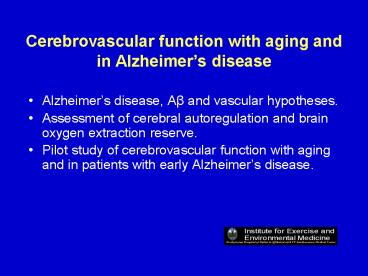Cerebrovascular function with aging and in Alzheimer - PowerPoint PPT Presentation
Title:
Cerebrovascular function with aging and in Alzheimer
Description:
Cerebrovascular function with aging and in Alzheimer s disease Alzheimer s disease, A and vascular hypotheses. Assessment of cerebral autoregulation and brain ... – PowerPoint PPT presentation
Number of Views:79
Avg rating:3.0/5.0
Title: Cerebrovascular function with aging and in Alzheimer
1
Cerebrovascular function with aging and in
Alzheimers disease
- Alzheimers disease, Aß and vascular hypotheses.
- Assessment of cerebral autoregulation and brain
oxygen extraction reserve. - Pilot study of cerebrovascular function with
aging and in patients with early Alzheimers
disease.
2
Alzheimer's Disease, Dr. Alois Alzheimer (1906).
President Ronald Reagan, Alzheimer's sufferer
3
The Impact of Alzheimer's Disease
4
AD Pathology Aß hypothesis
AD Plaque, ß amyloid deposition, amyloid
precursor protein, PS1, PS2 genes
Neurofibrillary Tangles, phosphorylated tau
protein
5
Vascular disease increases risk of AD
- Breteler MM. Vascular involvement in cognitive
decline and dementia. Epidemiologic evidence from
the Rotterdam Study and the Rotterdam Scan Study.
Ann N Y Acad Sci 903 457-465, 2000. - Zhu L, et al. Incidence of dementia in relation
to stroke and the apolipoprotein E epsilon4
allele in the very old. Findings from a
population-based longitudinal study. Stroke 31
53-60, 2000 - Seshadri S, et al. Plasma homocysteine as a risk
factor for dementia and Alzheimer's disease. N
Engl J Med 346 476-483, 2002. - Launer LJ, et al. Midlife blood pressure and
dementia the Honolulu-Asia aging study.
Neurobiol Aging 21 49-55, 2000. - Haan MN, et al. Prevalence of dementia in older
latinos The influence of Type 2 diabetes
mellitus, stroke, and genetic factors. J Am
Geriatr Soc 51 169-177, 2003.
6
De la Torre, Stroke 2002 331152
7
Alzheimers disease - Vascular Hypothesis
White matter lesions radiologic appearance of
vasculopathy of the small cerebral blood vessels.
Scheltens P, et al. Lancet Neurology 113-21,
2002
Cerebral amyloid angiopathy (98), microvascular
degeneration (100), microinfarctions (31),
intracerebral hemorrhages (7). Kalaria RN and
Ballard. Alzheimers Dis Assc Disord 13
s115-123, 1999
8
Hemodynamic and metabolic parameters of brain
Brain tissue has a very high aerobic metabolic
rate. Under resting conditions, about 15 20
of the cardiac output is received by the brain in
humans. This demand for oxygen supply is so
imperative that only a few seconds of ischemia is
sufficient to derange brain function profoundly
and result in syncope.
Nagata, Nuero Aging 2000 21301
9
Assessment of cerebrovascular function
- Cerebral autoregulation cerebral vessels dilate
or constrict to alter cerebrovascular resistance
to maintain CBF relatively constant in response
to changes in cerebral perfusion pressure. - Brain oxygen-extraction reserve The ability of
cerebral vasculature and brain tissue to maintain
cerebral metabolic rate for oxygen (CMRO2)
utilization relatively constant in response to
reduction in CBF.
10
Static cerebral autoregulation
Edvinsson and Krause. Cerebral Blood Flow and
Metabolism, 2002
11
Cerebral Autoregulatory and Oxidative Metabolic
Reserve
Stage 1
Stage 2
Ischemia
Nagata, Nuero Aging 2000 21301
12
Is cerebrovascular function impaired in patients
with Alzheimers disease?
13
Impaired cerebral autoregulation in transgenic
mice overexpressing APP
Niwa et al. Am J Physiol 283H315, 2002
14
Correlations between autoregulation dysfunction
index and brain concentrations of Aß
Niwa et al. Am J Physiol 283H315, 2002
15
Dynamic nature and variability of arterial blood
pressure
Sir George Pickering. Hypertension
Pathophysiology, Diagnosis and Management. 1995
(Bevan et. Clin Sci 1969)
16
Zone of risk of cerebral hypoperfusion
Lower limit of CBF autoregulation
24- hour blood Pressure variability
Cerebral blood flow
Global 24-hour blood Pressure mean.
Mean arterial blood pressure
17
Cerebral autoregulation with aging
Young
CBF
Old
50
150
80
CPP ( mmHg )
18
Cerebrovascular function with aging and in AD
Aging
Stiffness and degenerative changes in cerebral
vasculature
Impaired baroreflex function
Over-expression of Aß in AD
Rightward-shift or impaired cerebral
autoregulation
BP instability
Attenuated CBF response to hypotensive stimuli
Intermittent and transient brain ischemia,
neuronal dysfunction and death
19
TCD measurement of beat-to-beat changes in CBF
velocity
20
Static autoregulation with aging and in AD
21
Zhang et al. AJP, 1998
22
Dynamic cerebral autoregulation
2.0
mmHg
1.6
1.2
0.8
cm/sec/
0.4
0.0
1.5
1.0
0.5
radians
0.0
-0.5
-1.0
-1.5
1.0
Index
0.5
0.0
0.07
0.0
0.1
0.2
0.3
0.5
Frequency (Hz)
Zhang et al. AJP, 1998
23
BP and CBFV variability with aging and in AD
24
Changes in systemic and cerebral hemodynamics
during periodical squatting in a young subject
25
Changes in systemic and cerebral hemodynamics
during periodical squatting in patients with
early AD
26
Transfer function assessment of dynamic cerebral
autoregulation and baroreflex function
27
Conclusions
- Systemic and cerebral hemodynamic instability
increased in patients with early AD. - Static cerebral autoregulation during acute
hypotension is impaired in the elderly and in
patients with early AD. - Dynamic cerebral autoregulation as quantified by
transfer function analysis is impaired in the
elderly and to a greater extent in patients with
early AD. - Baroreflex function is impaired with aging to a
greater extent in patients with early AD.
28
Reduced cerebral vascular reserve in patients
with carotid artery occlusion
Derdeyn et al. Brain 125595, 2002
29
PET study of cerebral autoregulation and brain
oxygen extraction reserve
30
(No Transcript)
31
(No Transcript)
32
(No Transcript)
33
Conclusions
- CBV responses to hypotension are attenuated in
the elderly and in patients with early AD. - CBF is reduced during acute hypotension in early
AD suggesting impaired cerebral autoregulation. - Brain oxygen extraction reserve (as reflected by
the reduction in CMRO2 ) is reduced in patients
with early AD.
34
Central hypothesis
Cerebrovascular dysfunction plays an important
role in the pathogenesis and development of
Alzheimers disease.































